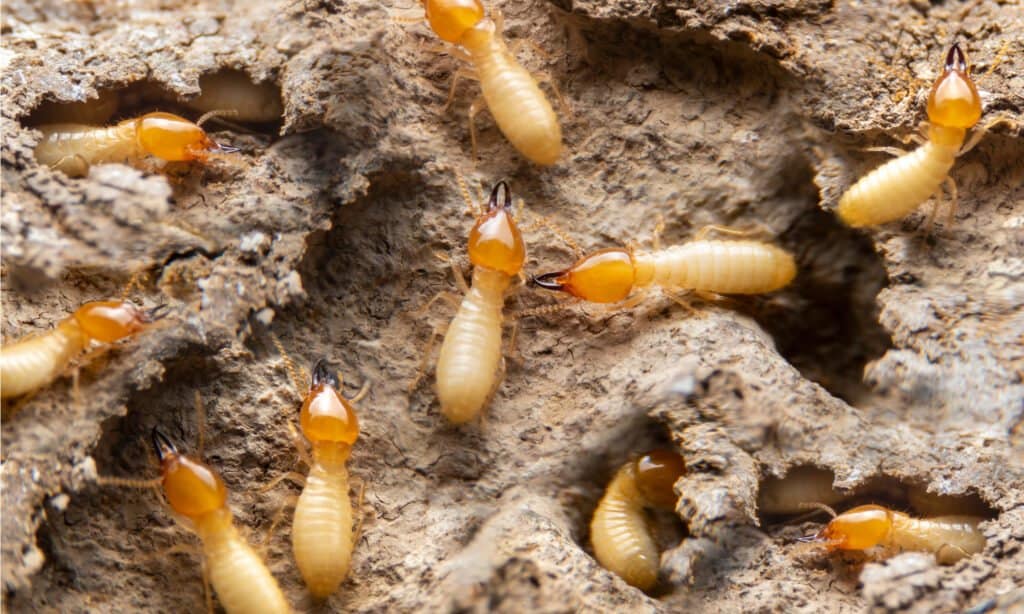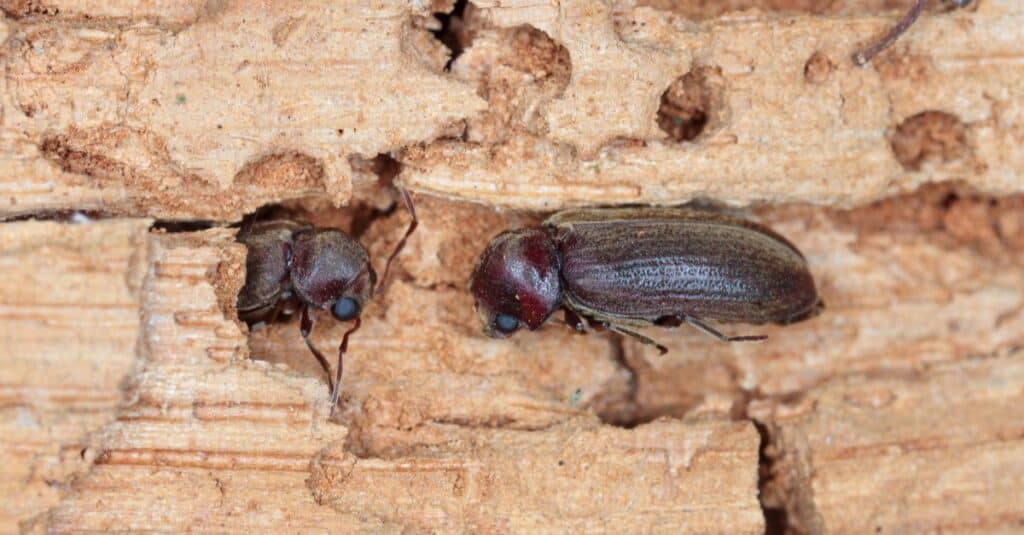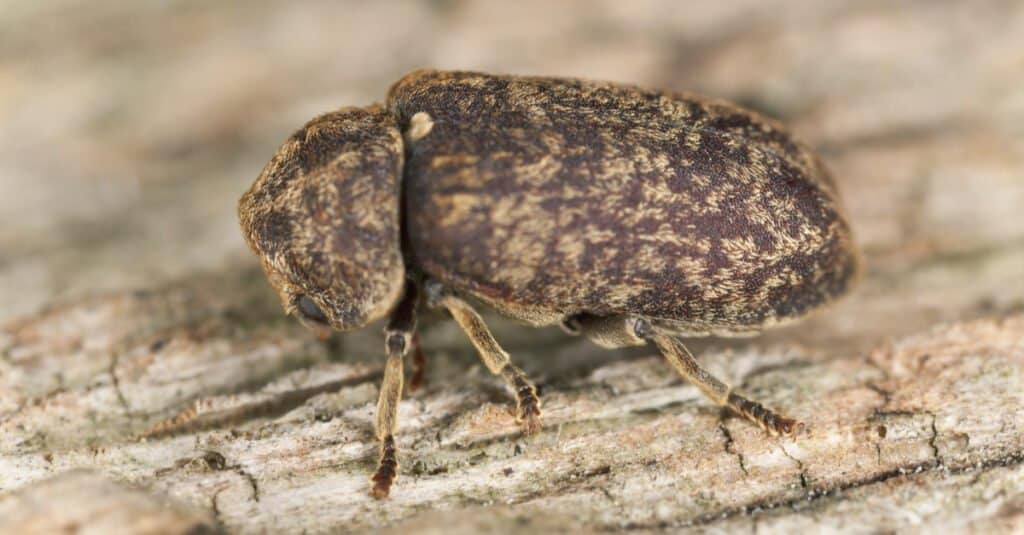Xylophagous animals are herbivores that eat wood exclusively or almost exclusively.
Summary
The word xylophagy is derived from the Greek word “xylo” (wood) and the suffix “-phagy” (to feed on.) Xylophagous animals eat and digest primarily wood.
Herbivores are animals that eat only plants. Within that group, there are many different types. Xylphagous animals are a type of herbivore that consumes and digests wood almost exclusively for their diet.
Many xylophagous animals are arthropods, such as termites and furniture beetles.
How to Pronounce Xylophagous
Xylophagous is pronounced [zai·laa·fuh·guhs]
Xylophagy Explained
Xylophagous animals feed on the cellulose of living or dead wood. Cellulose makes up the cell walls of plants, giving them structure. It’s what makes tree trunks powerful enough to support tall trees.
However, cellulose is difficult for most organisms to digest. Humans can’t digest it, but some animals, such as sheep, cows, and horses, have bacteria living in their intestines which lets them break down the cellulose in the plants they eat like grass and hay.
Some wood-eating insects rely on microbes in their gut to break down the cellulose found in wood, while others produce the enzymes necessary to break it down themselves.
Examples of Xylophagous Organisms
Many insects, and some other organisms, have developed specialized diets where they limit themselves to eating certain plant groups. Xylophagous animals have specialized diets consisting of wood. Some common examples include the following.
Termites
Termites eat wood to obtain cellulose. They break down cellulose and obtain nutrients from the bacteria that live in their digestive systems. Unfortunately for humans, termites look for cellulose sources from common household items such as wooden furniture, wooden framing, roofs, or any item made of wood.
Termites don’t sleep, but work 24 hours a day, eating, taking care of their queen, and building nests. Therefore, termites can do a lot of damage to a home in a short amount of time.

Infestation of termites can cause heavy damage to the structure of homes.
©Witsawat.S/Shutterstock.com
Furniture Beetles
Furniture beetles (Anobium punctatum) also feast on cellulose from wood. They are a type of wood-boring insect in the Ptinidae family. And like termites, they can cause a lot of physical damage to homes. The common furniture beetle can be found around the world. Despite their name, they don’t only eat furniture. They can cause damage to wood siding, crawl spaces, and wood flooring.

Common Furniture Beetles are a type of wood-boring insect in the
Ptinidaefamily.
©Tomasz Klejdysz/Shutterstock.com
Shipworms
Despite the name, shipworms are not worms, but bivalve mollusks in the family Teredinidae. Shipworms live with bacteria that break down the cellulose from wood for them. Shipworms are sometimes called the “termites of the sea”, and they feast on wood from wooden piers, ships, and docks.
Deathwatch Beetle
The deathwatch beetle is a wood-boring beetle in the same family (Ptinidae) as furniture beetles. It can eat all types of wood but prefers old oak structures. The beetle’s larva stage can last up to ten years, where it is enclosed in a pupa chamber inside the wood. Once the larva develops into an adult, its lifespan is only about a month.
This beetle gets its macabre name from its habit of tapping its head from inside tunnels in the wood where it lives. It is said that the ticking sounds made by the beetle were often heard by people “on watch” with a very ill person near death. Hence the name, “deathwatch” beetle.

Deathwatch beetles make ticking sounds inside of furniture by bumping their head or jaws against the sides of tunnels they have bored into.
©Henrik Larsson/Shutterstock.com
Catfish (Panaque)
There is a type of catfish (Panaque) that eats wood. Found in South America, they are one of the very few vertebrates that are xylophagous. So far, the Panaque species has only been found in the Magdalena, Orinoco, and Amazon River basins. Another name for them is “large armored catfish.”
Some other types of xylophagous organisms include:
- Giant wood moths (Cossidae)
- Wood roaches
- Horntail or wood wasps
- Woodlice
- Wood borers
- Squat lobster (Munidopsis andamanica)
- Gribble (Limnoria lignorum)
Are Beavers Xylophagous?
Beavers are herbivores, but there is some debate as to whether or not they are xylophagous. Although beavers can chew through logs, they don’t eat the hardwood from the trees they chew. A beaver’s gut, like that of a porcupine, contains symbiotic microbes that help them digest cellulose from a tree. However, wood is not their primary diet, and beavers tend to eat only the tree bark and the soft layer of wood underneath the bark. Beavers also eat twigs and soft vegetation.

Beavers eat tree bark, the soft layer of wood underneath, twigs, and soft vegetation.
©Frank Fichtmueller/Shutterstock.com
A few other mammals can digest wood (but it’s not their primary diet, and they are not considered xylophages) including:




